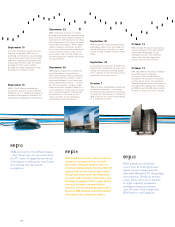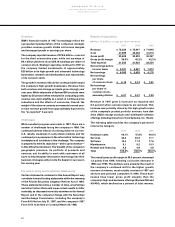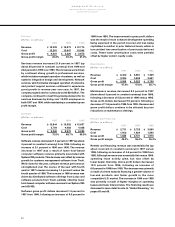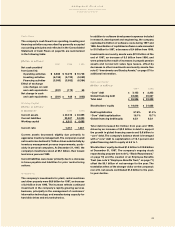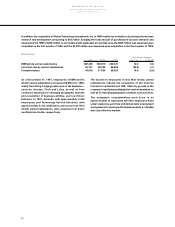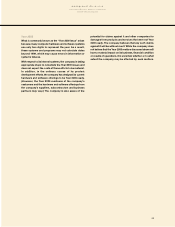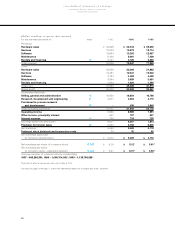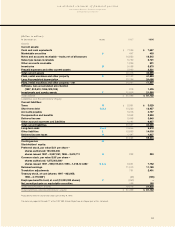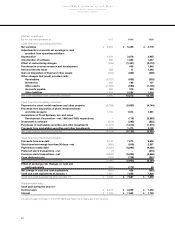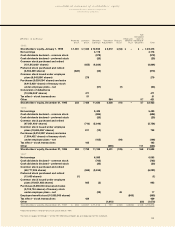IBM 1997 Annual Report Download - page 45
Download and view the complete annual report
Please find page 45 of the 1997 IBM annual report below. You can navigate through the pages in the report by either clicking on the pages listed below, or by using the keyword search tool below to find specific information within the annual report.
management discussion
International Business Machines Corporation
and Subsidiary Companies
Operating Expenses
(Dollars in millions)
1997 1996 1995
Selling, general and
administrative $16,634 $16,854 $16,766
Percentage of revenue 21.2% 22.2% 23.3%
Research, development
and engineering $4,877 $4,654 $4,170
Percentage of revenue 6.2% 6.1% 5.8%
Purchased in-process
research and
development $–$435 $1,840
Selling, general and administrative (SG&A) expense
declined 1.3 percent in 1997 versus 1996 and remained
essentially flat in 1996 compared to 1995. The company
continued its focus on reducing fixed infrastructure costs,
while increasing its investments in advertising, business
partner programs and emerging markets. These actions
yielded a 1.0 percentage point improvement in the
expense-to-revenue ratio in 1997 and a 1.1 percentage
point improvement in 1996.
The company continues to focus on productivity, expense
controls and prioritization of spending in order to achieve
a more competitive expense-to-revenue level.
Research, development and engineering expense
increased 4.8 percent in 1997 from 1996, following an
increase of 11.6 percent in 1996 from 1995. The increases
reflect the company’s continued investments in high-
growth opportunities like Java, network computing and
e-business, as well as the impact of additional expenses
associated with new acquisitions. Also, ongoing activities
of Lotus and Tivoli are included in 1996 and 1997 results,
as compared to 1995, which only included Lotus activity
between July and December 1995.
The benefits of the company’s ongoing research and
development have resulted in the company being granted
1,724 patents in 1997, placing it number one in the U.S.
for the fifth consecutive year. The application of these
technological advances has enabled the company to
transform this research and development into several
significant new product breakthroughs that will be found
in products beginning in 1998. Examples of these efforts
are the use of copper in place of aluminum in the making
of integrated circuits and the manufacturing of HDDs
using giant magnetoresistive head technology that
delivers a maximum areal density of about 2.6 billion bits
per square inch.
Purchased in-process research and development expense
in 1996 and 1995 was primarily associated with the Tivoli
and Lotus acquisitions, respectively.
On a constant currency basis, SG&A expense would have
increased approximately 2.7 percent in 1997 versus 1996,
and research, development and engineering expense
would have increased approximately 5.9 percent.
Provision for Income Taxes
The provision for income taxes resulted in an effective
tax rate of 33 percent for 1997, as compared to the 1996
effective tax rate of 37 percent and a 1995 effective tax rate
of 47 percent. Adjusting for purchased in-process research
and development which had no corresponding tax effect,
the 1996 and 1995 effective tax rates would have been
35 percent and 38 percent, respectively. The reduction in
the 1997 tax rate reflects the company’s continued
expansion into markets with lower effective tax rates.
The reduction in the 1996 tax rate was also due to the
company’s continued expansion into markets with lower
effective tax rates, as well as the use of foreign tax credits
to offset the tax effect of dividend repatriation from non-
U.S. affiliates.
The company accounts for income taxes under Statement
of Financial Accounting Standards (SFAS) 109, “Accounting
for Income Taxes,” which provides that a valuation
allowance should be recognized to reduce the deferred
tax asset to the amount that is more likely than not to be
realized. In assessing the likelihood of realization,
management considered estimates of future taxable
income, which are based primarily on recent financial
performance.
Fourth Quarter
For the quarter ended December 31, 1997, the company
had revenue of $23.7 billion, a 2.5 percent increase over
the same period of 1996. Net earnings in the fourth quarter
were $2,093 million ($2.16 per common share), compared
with net earnings of $2,023 million ($1.97 per common
share) in the fourth quarter of 1996.
Fourth-quarter revenue from the United States was
$9.5 billion, an increase of 8.9 percent from the same
period of 1996. Asia Pacific revenue was essentially flat
at $4.4 billion, while revenue from the company’s Europe,
Middle East and Africa units declined 4.4 percent to
$7.7 billion. Revenue in Latin America was $1.2 billion,
an increase of 4.4 percent and revenue from Canada
increased 14.2 percent to $.9 billion.
43



